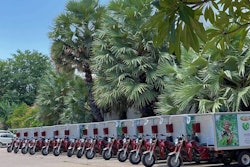
A key value of indoor farming is its ability to move food production closer to large population centers, bringing fresher, higher-quality crops to local communities while reducing the impact of long-haul transportation. However, as climate change continues to disrupt traditional field agriculture, some are making the case for expanding controlled environment agriculture (CEA) capabilities in America’s hard-hit farm belts.
Droughts, wildfires, floods and other weather extremes are ravaging key agricultural regions in the Western United States, burning millions of acres, displacing thousands due to rising water and causing untold damage and devastation to farms. These extreme weather events are making some crops in traditional field agriculture less reliable and more costly. Experts warn that these challenges will only intensify going forward.
The reality is that supplanting traditional field agriculture with massive numbers of indoor vertical farms isn’t feasible and can’t be done in a sustainable manner. For CEA to help farmers address the environmental impacts of climate change in the nation’s farm belts, we need a new approach, including new facility designs, systems and processes that run throughout the entire value chain from seed to sale. It’s time to rethink indoor farming.
One approach aims to take advantage of outdoor farming’s greatest resource – the sun – and integrate it into a more efficient CEA model. This way combines some of the key advantages of outdoor agriculture, traditional greenhouse technology and indoor vertical farming into a very untraditional fourth way of farming. It’s a new take on CEA designed to be more efficient and sustainable thanks to proprietary facility design, advanced materials, systems, operations and smart, data-driven and real-time response automation. This innovative, new model promises to give consumers a clean, green and better process that will result in more nutritious and better-tasting food.
This way creates a highly automated, precision grow environment within a fully-sealed building envelope that uses natural sunlight with the support of supplemental artificial lighting. This fully-sealed facility design is a near ideal solution for farming regions hard hit by ongoing drought conditions because it conserves water, getting up to 90% of the crop’s needs from within the building envelope. Water savings are achieved in large part through hydroponics, which are inherently more water-efficient than field agriculture. However, unlike hydroponics used in indoor vertical farms, this model employs a variety of water recapture and automated processes developed to achieve much greater efficiencies and conservation than conventional hydroponic grow operations, with higher crop yields.
The precision grow environment not only conserves water, but it also blocks out virtually all external toxins and pathogens – removing the need for herbicides, pesticides and irradiation. In addition, it was designed to lower operating costs, using substantially less energy and fertilizer compared to indoor farms and provides a significant reduction in labor costs.
Bringing the outdoors in
Sunlight is the big advantage of outdoor agriculture because it helps plants achieve their full genetic potential. There is nothing like natural sunlight when it comes to farming. This new way employs a high-tech, high-efficiency building envelope and advanced construction engineering and materials to, in effect, allow as much natural sunlight indoors as is possible, with the support of supplemental grow lighting.
Unlike the glass and polycarbonate materials used in greenhouses – which do not allow for a full light spectrum to enter the facility – this design employs a breakthrough material allowing for the penetration of virtually the full light and RV spectrum of the sun. When the sun isn’t shining, advanced LED lighting systems automatically engage to supplement for optimal growing conditions. In addition to saving on energy costs, natural sunlight warms the indoor microclimate and can reduce heating energy requirements.
The building envelope is a unique tensile, double-walled facility with captured airspace that facilitates deployment of organic, “virtual clouds” that supply superior translucent insulation. The virtual clouds dynamically respond to real-time data about external weather, light and climate conditions. They allow for solar gain control and the diffusion of light without affecting the light spectrum. This solar foam also provides the ability to manage the temperature of the facility in a more natural, cost-effective and sustainable way.
All the systems and processes are controlled and automated using the Internet of Things (IoT) and artificial intelligence (AI), which are integrated into every component of the growing environment. This includes critical sensing and monitoring interface equipment, advanced AgTech automated grow systems, proprietary high-efficiency grow channels and hybrid nutrient systems. Added to this are specially designed operating processes, procedures and elements that support the holistic and integrated approach to cultivation.
Final thoughts
With traditional farming under siege from increasing climate crises, it’s essential that the agricultural industry develop new ways to increase resiliency. This includes making a positive change in agriculture through a carefully controlled indoor environment that is different than typical greenhouses or other indoor farming facilities and that improves upon outdated legacy systems. Using a precision ecosystem for growing, farmers can deal with the vagaries of nature – wind, flood, drought, etc. – and ultimately improve agricultural yield, nutrition, flavor, productivity, and most importantly, sustainability.

















